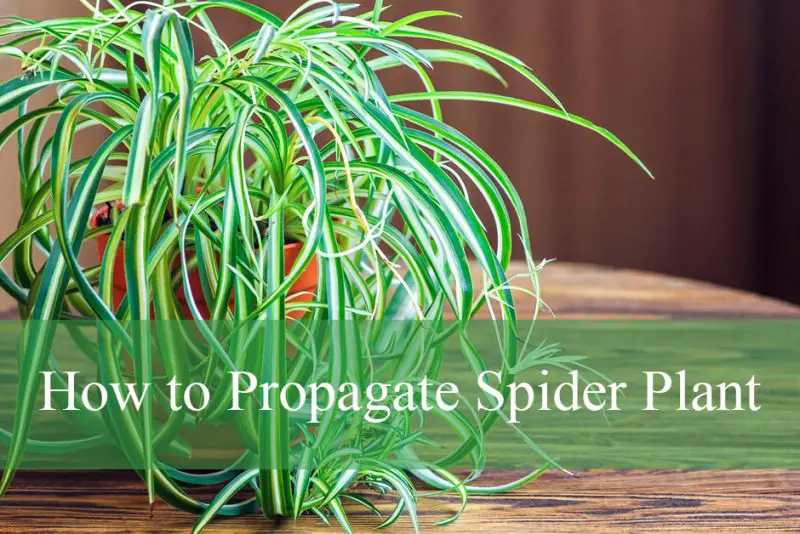Propagating a spider plant, also known as Chlorophytum comosum, is one of the most satisfying and beginner-friendly gardening tasks. Its simplicity and high success rate make it an excellent choice for new plant enthusiasts.
Whether you’re hoping to grow your houseplant collection, share cuttings with a friend, or enjoy watching new life take root, learning how to propagate spider plant in water or soil is a rewarding and fast process.
Thanks to its resilience, attractive arching leaves, and the abundance of baby offshoots it produces, the spider plant is one of the easiest and most popular plants to propagate indoors.
Understanding Spider Plant Growth and Propagation

The spider plant is a perennial evergreen herb that thrives as a houseplant due to its adaptability and ease of care. Native to South Africa, this plant produces long, arching green leaves with white or light green stripes. As the plant matures, it develops stolons or runners from the base, which produce baby plantlets. These plantlets, often called “spiderettes,” are what make propagation possible.
Spider plant propagation is so easy because the plant naturally produces these offshoots that already resemble miniature versions of the parent. Each spiderette has small root nodules or even visible roots before being detached. This unique feature makes the process almost foolproof. Whether you choose to root them in water or directly into soil, the plantlets adapt quickly and grow into full plants with proper care.
Understanding this growth habit allows you to take full advantage of the spider plant’s natural tendency to reproduce. It’s not only a great way to multiply your plants, but also a method to rejuvenate older specimens that may have become leggy or less vigorous over time.
When to Propagate Spider Plants for Best Results
Although spider plants can technically be propagated year-round indoors, the best time to propagate them is during the spring and summer months. These seasons mark the plant’s active growth period, which means any new plantlets or roots will establish faster and stronger.
During the winter months, spider plants tend to slow their growth and may not produce as many offshoots. Propagation is still possible, but root development may take longer. If your plant has recently flowered and produced new babies, this is an ideal moment to begin propagation, as the plantlets are usually full of energy and primed for rooting.
It is also wise to propagate after repotting or pruning your spider plant. This period of adjustment often triggers new growth, and the additional space and nutrients from repotting help support healthy root development in new cuttings. If your spider plant has become root-bound or is producing many spiderettes, this is your cue that it’s time to propagate.
Preparing Your Spider Plant for Propagation
Before beginning the propagation process, ensure your spider plant is healthy and free from pests or diseases. Look for vibrant, well-formed plantlets that are at least two to three inches long. These baby plants should have small roots forming at the base or visible root nubs along the stem. The more developed the roots, the easier and quicker the propagation will be.
To separate the plantlets, gently snip or pinch them off close to the base of the runner. Use a sterilized pair of scissors or pruners to avoid introducing pathogens to either the mother plant or the baby. You can also detach spiderettes that are still attached to the runner and root them while connected, although rooting them after full separation is the more common and practical method.
It’s helpful to prepare your containers and growing media ahead of time. For water propagation, choose a clear glass or jar filled with clean, room-temperature water. For soil propagation, select a small pot with drainage holes and fill it with a lightweight, well-draining mix suitable for houseplants. Ensuring all materials are clean and ready will set you up for success.
Propagating Spider Plant in Water
Water propagation is one of the easiest and most satisfying ways to root spider plant babies. Watching the roots grow through the glass adds an element of fun and allows you to monitor progress in real time. Place the base of each spiderette in water, making sure only the root area is submerged while the leaves remain above the water line.
Position your water container in a bright location with indirect sunlight. Avoid placing it in full sun, as this can cause the water to overheat and damage the cutting. Change the water every few days to prevent bacterial growth and keep the oxygen levels high. Within one to two weeks, you should begin to see white roots extending from the base of the plantlet.
Once the roots are at least one to two inches long, the plantlet is ready to be transferred into soil. Gently remove it from the water and plant it in a small pot filled with moist, well-draining soil. Press the soil around the roots to secure it and water lightly. The plant may take a few days to adjust, but new growth should soon follow.
Propagating Spider Plant in Soil
Soil propagation is an equally effective method that allows spider plant babies to establish roots directly in their permanent growing medium. Some gardeners prefer this method because it eliminates the need for transplanting later. Begin by slightly moistening the soil in your chosen container so it is damp but not soggy.
Insert the base of the spiderette into the soil, covering any visible root nubs while keeping the leaves above the surface. Press the soil gently around the stem to stabilize the plantlet. Place the container in a bright area with filtered light and moderate warmth. A temperature range between 65°F and 75°F is ideal for encouraging root development.
Water sparingly during the first week, allowing the soil surface to dry out slightly between waterings. Too much moisture at this stage can cause the base of the plantlet to rot. Within two to three weeks, the plantlet should begin to root and show signs of new growth. Once established, it can be treated like a mature spider plant.
Caring for Newly Propagated Spider Plants
After propagation, it is important to provide the right environment to support your new spider plant’s early development. Whether started in water or soil, young plants need consistent moisture, indirect sunlight, and a stable temperature. Avoid drafts, direct sun, and overly dry air, which can stress the new roots.
If you propagated in water and have just transferred the plant to soil, give it time to adjust to the new conditions. Don’t overwater during this period. A light watering once the soil begins to dry out is sufficient. Keep the plant in a partially shaded area until it begins growing actively.
Over the next few weeks, gradually introduce the plant to brighter light, and begin a regular care routine that includes watering when the top inch of soil is dry. Fertilize monthly with a diluted houseplant fertilizer during the growing season. With good care, your propagated spider plant will grow rapidly, developing new leaves and eventually producing spiderettes of its own.
Speeding Up the Propagation Process
If you’re looking to accelerate propagation, start by choosing mature spiderettes that already have visible roots. These will root faster than younger or undeveloped plantlets. Warm temperatures and consistent humidity also promote rapid root growth. You can increase humidity by placing a plastic cover or humidity dome over the pot, as long as it allows for some airflow.
Using a rooting hormone, although not necessary, can speed up the process, especially in soil propagation. Dip the cut base of the spiderette in rooting powder before planting. This stimulates quicker root formation and increases success rates.
Supplemental lighting from a grow light can also help if your home lacks bright natural light. Spider plants respond well to artificial lighting, especially during darker months. Providing 10 to 12 hours of light daily will encourage stronger and faster development in new plants.
Avoiding Common Propagation Mistakes
Propagation is generally easy with spider plants, but a few common mistakes can hinder your success. One of the most frequent errors is overwatering, particularly when propagating in soil. Excess moisture can lead to rot, which kills the plant before it can root. Always use well-draining soil and allow it to dry slightly between waterings.
Another issue is placing cuttings in direct sunlight. While spider plants like bright light, intense sun can scorch delicate plantlets or overheat water containers. Indirect light or filtered sunlight is always the best choice during the rooting phase.
Using plantlets that are too immature is another reason for failed propagation. Always wait until the baby spider plant has grown large enough, with visible root nubs or a couple of inches in length, before attempting to root it. Rushing this step often results in cuttings that fail to thrive.
Transplanting and Long-Term Care
Once your propagated spider plants are rooted and showing new growth, it’s time to think about their long-term care and eventual transplanting into larger pots. Wait until the new plant outgrows its small starter pot before moving it. Signs include roots growing out of the drainage holes or soil drying out too quickly.
Transplant into a slightly larger pot with fresh, well-draining soil. Avoid jumping to a container that is too big, as excess soil can retain moisture and increase the risk of rot. Water thoroughly after transplanting and allow the plant to settle in a shaded spot for a few days before returning it to its regular growing location.
With regular care, your new spider plant will mature quickly. Continue to water when the soil is dry to the touch and provide balanced fertilizer during the active growing season. Prune yellowing leaves and trim older runners to maintain the plant’s shape and vigor.
Benefits of Propagating Spider Plants
Propagating spider plants not only allows you to expand your indoor garden for free, but it also helps rejuvenate your existing plants. Older spider plants that are regularly trimmed and propagated tend to stay healthier and produce more foliage. The babies you grow can be shared with friends, gifted in decorative pots, or even used as natural air purifiers in various rooms around your home.
Spider plants are known for their ability to clean the air of common pollutants like formaldehyde and carbon monoxide. By propagating and placing these plants in different rooms, you enhance both the aesthetic and environmental quality of your indoor spaces.
Propagation also offers a wonderful learning opportunity for children and new plant enthusiasts. Watching a plant grow from a tiny offshoot into a full, thriving specimen is a powerful demonstration of nature’s regenerative capacity.
FAQs About Spider Plant Propagation
Can I propagate spider plant without roots?
Yes, as long as the spiderette is mature enough. Root nodules will develop quickly in water or soil.
How long does it take for spider plant cuttings to root?
In water, roots may appear within 7 to 14 days. In soil, it may take slightly longer, depending on conditions.
Should I use rooting hormone for spider plant propagation?
It’s not necessary, but it can help speed up rooting, especially in soil.
How often should I water propagated spider plant babies?
Water lightly when the top layer of soil feels dry. Avoid letting the soil stay soggy.
Can spider plants be propagated directly in their hanging pot?
Yes, you can root the babies while they are still attached, or place small pots below the mother plant to catch the runners.
Final Thoughts on Spider Plant Propagation
Learning how to propagate spider plant in water or soil the easy way opens up a rewarding and low-stress path into plant care and indoor gardening. With its forgiving nature and built-in baby offshoots, the spider plant is one of the most generous and beginner-friendly houseplants you can grow.
Whether you’re multiplying plants for yourself, sharing with others, or simply enjoying the beauty of new life, spider plant propagation is a joyful and educational process. As long as you provide the right conditions—healthy plantlets, indirect light, well-draining medium, and a little patience—your efforts are sure to be rewarded with flourishing greenery.






